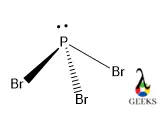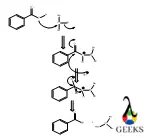PBr3 is the tri-halogenated molecule of phosphorus where the central atom is sp3 hybridized along with lone pairs. Let us discuss the PBr3 in detail.
PBr3 or phosphorus tribromide can be formed by the reaction of red phosphorus and bromine. White phosphorous does not participate in this reaction, because it is inert in nature. In organic chemistry, PBr3 has greater importance because it can replace the -OH group with bromine and form alkyl bromide.
Similar way phosphorus tribromide can convert carboxylic acid to acyl bromides. Here we should discuss some basic properties of PBr3 with a proper explanation like oxidation state, crystal, acidity, and basicity in the following part of the article.
1. PBr3 IUPAC name
The IUPAC (International Union Pure and Applied Chemistry) name of the PBr3 is phosphorus tribromide as bromine is present as an anionic part, so “de” is added as a suffix, and three is called tri. It is also known as tribromophosphine.
2. PBr3 chemical formula
The chemical formula of phosphorus tribromide is PBr3, as there are phosphorous and bromine present a 3:1 proportion, and the chemical formula should give an idea about the stoichiometric ratio of the elements in a particular molecule. As P bears the cationic part so it comes first followed by three bromide ions.
3. PBr3 CAS number
7789-60-8 is the CAS number (up to 10 digits number given by chemical abstract service) of PBr3 and using this number we can get information about the molecule.
4. PBr3 Chem Spider ID
PBr3 has chem spider ID 23016 (given by the Royal Society of Science like the CAS number which is unique for each molecule).
5. PBr3 chemical classification
PBr3 is classified into the following categories,
- PBr3 is strong lewis acid
- PBr3 is a π-acidic ligand
- PBr3 is an organic reagent
- PBr3 is an inorganic covalent molecule
6. PBr3 molar mass
PBr3 has a molar mass of 270.069 g/mol which is the summation of the atomic mass of P and three Br atoms. The atomic mass of P is 39.0983 and atomic mass of Br is 79.904 and molar mass of PBr3 is 39.0983 + (79.904*3) = 270.069 g/mol (as three Br atoms are present so multiplying the stoichiometric proportion).
7. PBr3 color
PBr3 is a colorless liquid so it has not a specific color, due to the electronic transition between P to Br being so high that the corresponding wavelength does not fall in the visible region and it appears to be colorless.
8. PBr3 viscosity
For the liquid PBr3 , the viscosity is 0.001302 pas at room temperature, it is the force by the liquid for deformation at the given rate. The solid or gaseous form did not have viscosity as it is the property for liquid only. It can be calculated by the formula, F = µA(u/y), where F is applied force, µ is viscosity.
9. PBr3 molar density
PBr3 has a molar density of 2.852 g/L which is coming from the calculation by dividing the total molecular mass of the molecule by volume. The total molecular weight of PBr3 is 270.069 g/mol and the volume as per Avagardo’s calculation is 22.4L for a gaseous molecule.
10. PBr3 melting point
PBr3 has a lower melting point like -41.50C or 231.5K because at room temperature.
11. PBr3 boiling point
The boiling point of the tribromophosphine is 173.20C or 446.2K .
12. PBr3 state at room temperature
PBr3 appears to be a colorless liquid at room temperature because its crystal is stable at very low temperatures.
13. PBr3 covalent bond
A covalent bond is present between P and three Br atoms in phosphorus tribromide. Because like a covalent bond, the central P atom is sp3 hybridized here, and all the electrons of P and Br are shared in the single bond covalent. There is no full donation of electrons in those bonds present so bonds are pure covalent.
14. PBr3 covalent radius
The covalent radius of the PBr3 is 195 pm which is the atomic radius of the P itself, because we cannot predict the covalent radius for the molecule it can be determined for the single atom only. As P is central atom so, we consider the covalent radius of P only, which is corresponding to its van der waal’s radius.
15. PBr3 electron configurations
Electron configuration is the arrangement of electrons in a particular shell having a particular quantum number of an element. Let us find the electron configuration of PBr3.
The electronic configurations of PBr3 are [Ne]3s23p3 and [Ar]3d104s24p5 which are the respective configuration of constituent atoms P and Br. In PBr3 there are three bond pairs and ten lone pairs are present which can be described by its lewis structure, each Br atom contains three lone pairs and one for P.
16. PBr3 oxidation state
The oxidation state of central P is +3 as forms three covalent bonds with three Br atoms and its valency is also the same. For each Br, the oxidation state is -1 as there is one elect that is missing the valence orbital of each Br. So, each valency and oxidation state are matching for PBr3 (+3 for P and -1 for 3 Br).
17. PBr3 acidity
PBr3 is acidic in nature rather it is strong lewis acid due to the presence of vacant d orbital of P, so it can accept electrons from the suitable lewis base or electron-rich system. Due to the three electronegative Br atoms, they pulled the electron density from the P site, and its lewis acidity further increases.
18. Is PBr3 odorless?
PBr3 is not odorless it has a pungent smell due to the hydrolysis of the molecule to the formation of hydrobromic acid.
19. Is PBr3 paramagnetic?
The paramagnetic nature of a molecule depends on the availability of unpaired electrons in the valence shell. Let us see whether PBr3 is paramagnetic or not.
PBr3 is not paramagnetic rather it is diamagnetic because the central P has two paired electrons in its sp3 hybridized orbital, so it acts as diamagnetic, and also there are three paired electrons present for each F atom as lone pairs.
20. PBr3 hydrates
There is no such hydrated part present in the crystal form of the PBr3 molecule but it can undergo rapid hydrolysis from hydrobromic acid. It is a hydrophobic molecule. The electronegative F atoms can be attached to the water molecule by the H-bond because they form the best hydrogen bond.
21. PBr3 crystal structure
In the lattice form, PBr3 adopts orthorhombic crystal where a, b, and c values for the lattice crystal are 696, 936, and 1097 pm and α, β, and γ values are 900. There is a total of 16 atoms present in a single crystal which means four PBr3 molecules per crystal and it is a zero-dimensional crystal lattice.
22. PBr3 polarity and conductivity
PBr3 can conduct electricity due to its electrolytic nature, P is attached to three electronegative f atoms, so here a dipole flow occurs from F to P, and due to the asymmetric shape (trigonal planer), there is a resultant dipole-moment present, and makes the molecule polar.

23. PBr3 reaction with acid
PBr3 itself is an acid molecule so the reaction of acid is very little but it can react with the organic acid molecules to form corresponding acyl bromide and the reaction proceed via nucleophilic substitution bimolecular pathway (SN2 mechanism). It is also known as Hell-Volhard-Zelinsky halogenation
C6H5-COOH + PBr3 = C6H5-COOBr

24. PBr3 reaction with base
Being a lewis acid it can react with lewis bases accept the lone pairs or electron density from them and formed an adduct or complex.
PBr3 + NH3 = H3N-PBr3
25. PBr3 reaction with oxide
Being a good reagent in organic chemistry it can react with oxides especially acidic oxides which consist of non-metal and also it can react with -OH functionality to form alkyl bromide flowed by the nucleophilic substitution bimolecular pathway (SN2 mechanism).
CH3-OH + PBr3 = CH3-Br
26. PBr3 reaction with the metal
Due to the lower reduction potential of phosphorus than transition metal, it cannot reduce metal and not react with metal for displacement reaction.
Conclusion
Tribromophosphine or phosphorus tribromide is a useful reagent for organic chemistry. It can react with primary as well as secondary -OH groups to form corresponding alkyl bromide, and this is the best reagent for the formation of alkyl halide via an SN2 reaction.

Hi……I am Biswarup Chandra Dey, I have completed my Master’s in Chemistry from the Central University of Punjab. My area of specialization is Inorganic Chemistry. Chemistry is not all about reading line by line and memorizing, it is a concept to understand in an easy way and here I am sharing with you the concept about chemistry which I learn because knowledge is worth to share it.